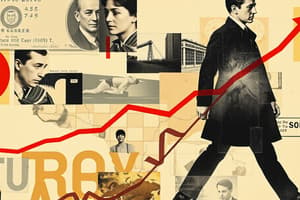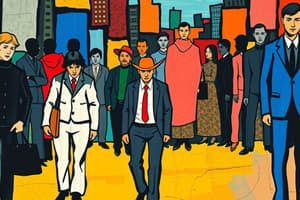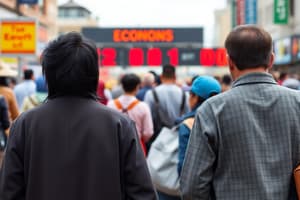Podcast
Questions and Answers
What type of unemployment occurs when individuals with skills cannot find suitable jobs?
What type of unemployment occurs when individuals with skills cannot find suitable jobs?
Disguised unemployment refers to individuals actively engaged in productive work.
Disguised unemployment refers to individuals actively engaged in productive work.
False (B)
What is the term for unemployment caused by technological advancements?
What is the term for unemployment caused by technological advancements?
Technological unemployment
A significant issue causing unemployment in India is ____ growth, where employment growth is slower than economic growth.
A significant issue causing unemployment in India is ____ growth, where employment growth is slower than economic growth.
Signup and view all the answers
Match the following terms with their descriptions:
Match the following terms with their descriptions:
Signup and view all the answers
Which of the following is NOT a cause of unemployment in India?
Which of the following is NOT a cause of unemployment in India?
Signup and view all the answers
Frictional unemployment is only caused by technological advancement.
Frictional unemployment is only caused by technological advancement.
Signup and view all the answers
Name one type of rural unemployment.
Name one type of rural unemployment.
Signup and view all the answers
What significant problem does inflation primarily affect?
What significant problem does inflation primarily affect?
Signup and view all the answers
The Vicious Circle of Poverty refers to a cycle where high income leads to more savings and investments.
The Vicious Circle of Poverty refers to a cycle where high income leads to more savings and investments.
Signup and view all the answers
Name one measure undertaken for poverty eradication related to agriculture.
Name one measure undertaken for poverty eradication related to agriculture.
Signup and view all the answers
The primary goal of the UN Sustainable Development Goals is to end _____ in all its forms and dimensions.
The primary goal of the UN Sustainable Development Goals is to end _____ in all its forms and dimensions.
Signup and view all the answers
Match the following measures with their purposes:
Match the following measures with their purposes:
Signup and view all the answers
Which regions are identified as lagging behind in terms of economic development?
Which regions are identified as lagging behind in terms of economic development?
Signup and view all the answers
Affordable housing is an initiative only targeted towards urban poor.
Affordable housing is an initiative only targeted towards urban poor.
Signup and view all the answers
What is one effect of poverty on the economic progress of a country?
What is one effect of poverty on the economic progress of a country?
Signup and view all the answers
Family Welfare Programs and population policies have been introduced to control the _____ growth.
Family Welfare Programs and population policies have been introduced to control the _____ growth.
Signup and view all the answers
Which Sustainable Development Goal does India prioritize for 2030?
Which Sustainable Development Goal does India prioritize for 2030?
Signup and view all the answers
What is one of the significant economic effects of unemployment?
What is one of the significant economic effects of unemployment?
Signup and view all the answers
Relative poverty refers to a situation where individuals lack basic resources.
Relative poverty refers to a situation where individuals lack basic resources.
Signup and view all the answers
What is the poverty line based on?
What is the poverty line based on?
Signup and view all the answers
The scheme that guarantees 100 days of wage employment in a financial year is called __________.
The scheme that guarantees 100 days of wage employment in a financial year is called __________.
Signup and view all the answers
Which of the following is NOT a specific measure to reduce unemployment?
Which of the following is NOT a specific measure to reduce unemployment?
Signup and view all the answers
The poverty ratio measures the total population living below the poverty line.
The poverty ratio measures the total population living below the poverty line.
Signup and view all the answers
Name one major cause of poverty in India.
Name one major cause of poverty in India.
Signup and view all the answers
The minimum calorie intake required for a person living in rural areas is __________ calories per day.
The minimum calorie intake required for a person living in rural areas is __________ calories per day.
Signup and view all the answers
Which measure is aimed at creating employment opportunities in backward districts?
Which measure is aimed at creating employment opportunities in backward districts?
Signup and view all the answers
Match the following schemes with their objectives:
Match the following schemes with their objectives:
Signup and view all the answers
Economic development is crucial for reducing unemployment.
Economic development is crucial for reducing unemployment.
Signup and view all the answers
What is the objective of the Training Rural Youth for Self-employment (TRYSEM) scheme?
What is the objective of the Training Rural Youth for Self-employment (TRYSEM) scheme?
Signup and view all the answers
The poverty ratio in urban areas according to the Planning Commission report for 2011-12 was __________%.
The poverty ratio in urban areas according to the Planning Commission report for 2011-12 was __________%.
Signup and view all the answers
Which state had the highest poverty ratio in India as of 2011-12?
Which state had the highest poverty ratio in India as of 2011-12?
Signup and view all the answers
The growth of the informal sector is a positive effect of unemployment.
The growth of the informal sector is a positive effect of unemployment.
Signup and view all the answers
What does the term 'absolute poverty' refer to?
What does the term 'absolute poverty' refer to?
Signup and view all the answers
Study Notes
Unemployment
- Unemployment is a significant economic and social issue.
- It involves individuals willing and able to work but unable to find employment.
-
Rural Unemployment:
- Seasonal unemployment occurs in agriculture due to seasonal work variations.
- Disguised unemployment happens when individuals appear employed but don't engage in productive work that matches their skills.
-
Urban Unemployment:
- Educated unemployment is when educated individuals with skills can't secure suitable jobs.
-
Industrial unemployment arises in the industrial sector due to factors like technological advancement, slow growth, or lack of training.
- Technological unemployment results from job displacement caused by technological advancements.
- Frictional unemployment happens due to temporary factors like strikes, power failures, or job-seeking time.
- Cyclical unemployment occurs due to economic fluctuations, with job losses in recessions.
- Structural unemployment arises from long-term economic changes like shifts in demand or policies.
-
Causes of Unemployment in India:
- Job creation rate is slower than economic growth, not creating enough jobs for workforce increase.
- Rising labor force due to declining death rates and stable birth rates.
- Increased use of capital-intensive technology reduced labor demand.
- Inadequate skill development programs, a gap between workforce skills and industry needs.
- Aspiration for white-collar jobs without matching entrepreneurial spirit.
- Seasonal agriculture is a major employer, but has idle periods.
- Slow economic development limits industries and job opportunities.
- Rural-to-urban migration increases urban unemployment.
-
Effects of Unemployment:
- Human resource wastage, difficulty with welfare schemes, poverty, income inequality and informal sector growth.
- Social unrest, loss of dignity, and helplessness.
-
Measures to Reduce Unemployment:
- Agricultural development, alternative occupations, infrastructure, educational reforms, tourism, and IT development.
- Adopting labour-intensive techniques, vocational training, rural industrialization, inspiring self-employment.
- Government schemes like EGS, SGSY, SJSRY, PMRY, TRYSEM, JRY, MGNREGS, and others are specific initiatives for job creation.
Poverty
- Poverty is a significant economic and social problem characterized by resource deprivation, hindering basic needs fulfillment.
-
Concepts of Poverty:
- Absolute poverty is based on minimum calorie intake needs.
- Relative poverty compares living standards within a society.
- Poverty Line: An expenditure threshold distinguishing the poor from the non-poor, calculated based on monthly per capita consumption.
-
Objectives of the poverty line:
- Estimate population below the poverty line.
- Identify poor based on household consumption expenditure.
- Track poverty changes over time and across regions.
- Estimate expenditure needed for poverty alleviation programs.
- Extent of Poverty in India: Measured by the poverty ratio (poor population percentage).
- Estimates: The government appointed committees review the poverty line. The 2012 Expert Group, chaired by Dr. Rangarajan, provided poverty lines based on monthly per capita consumption in 2011-12. Data is provided in a table.
- State-wise Poverty Ratios: Varied considerably, with higher poverty in Uttar Pradesh and Bihar, and lower in Kerala.
-
Causes of Poverty:
- Population explosion, slow economic growth, unemployment, economic inequalities, inadequate infrastructure, inflation, regional imbalances, and the vicious circle of poverty.
-
Effects of Poverty:
- Slow economic progress, low national income, low living standards, low savings and investment, conflicts between classes, social issues, environmental degradation. and government burden
-
Measures for Poverty Eradication:
- Population control, agricultural support, rural work, rural industrialization, minimum wages, public distribution system, nationalized banks, progressive taxes, education, affordable housing, and health facilities.
Sustainable Development Goals (SDGs)
- The UN SDGs, adopted in 2015, address social, economic, and environmental issues globally.
- They aim to end poverty in all forms.
- There are 17 SDGs and 169 targets to be achieved by 2030.
- India, a signatory to the UN, played a role in shaping the SDGs
- Goal 1 focuses on eradicating poverty by 2030.
Studying That Suits You
Use AI to generate personalized quizzes and flashcards to suit your learning preferences.
Description
Test your knowledge on the various types of unemployment, including rural and urban aspects. Understand the causes and implications of seasonal, educated, and technological unemployment. This quiz covers the significant economic and social issues surrounding unemployment.




